|
Monday, July 26, 2010
Progress Notes
In past editions of Progress Notes I have placed on this page histories of some of the towns of Miller County. These have included:
Tuscumbia, Brumley, Mary’s Home and St. Elizabeth.
Eldon references included an article on its railroad history and another about the Harvey family.
A third article about Eldon summarized its very early history.
This week I wanted to place on our website the Iberia history as written by Peggy Hake, our much respected Miller County historian, who was born and raised in Iberia (photo 01).
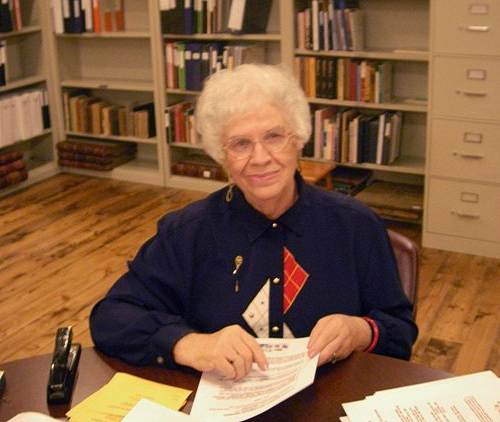
01 Peggy Hake Our website has a page to which you can refer which directs you to short summaries of all our communities.
However, on the Progress Notes page I have the opportunity to present longer articles such as the one this week which Peggy wrote about her hometown, Iberia. I will place an old plat map of Iberia here for your reference regarding some of the locations Peggy mentions about Iberia in her article (photo 02):
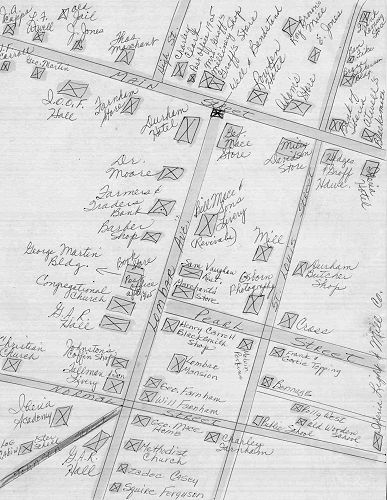
02 Iberia Map - 1910
Click image for larger viewIberia is a rare name…she doesn’t appear very often in written history, so trying to search the source of where the name originated has been difficult. The name first appeared in the Celtic history of the Old World. It was referred to as IBERIA in that ancient land of Spain and later the peninsula of Spain and Portugal was known as the Iberian Peninsula and today, history scholars are still taught this fact. The only other Iberia found in the United States or her Territories is New Iberia, Louisiana. My home town Iberia has the distinction of surviving through the 139 years without her name changing (unless you count the name she has been known over the years of “Rocktown”).
A most interesting item I found, while researching, was a quotation in an old manuscript which was a sermon preached by the Reverend William Symonds in White Chapel, England, in the year 1609. He was preaching to the Jamestown bound colonists, who were getting ready to sail for the New World. These folks were in the need of spiritual uplifting for they were leaving family, friends, and home and the following is a portion of his text: “A captive girl brought Naman to the Prophet; a captive woman was the means of converting IBERIA…God makes the weak things of the world confound the mighty and getteth himself praise by the mouths of babes and sucklings.”
So in the year 1609, the name of Iberia was a familiar one to these English folks who were the forerunners of our own ancestors to the American soil.
The present site of Iberia has seen many peoples and customs. The Indian once roamed her streams, fields, and prairies. The first recorded person living on the present site was George Tall Bear, an Indian, who stayed on even after the white man had treaded on the land of the Osage tribes. Judge Jenkins in his book, “History of Miller County,” describes very thoroughly and colorfully the customs and lives of these Osage Indians. It is most interesting to read his vivid records.
The year 1840 was the first time in recorded Miller County history, Iberia, as a name, appeared on an official document. Thirty two residents of the county living south of the Osage River petitioned the County Court for a road that would lead from Iberia’s post office northward to the Davis ferry on the Osage and on northward toward Jefferson City. I’m not sure how Iberia received her name. The legend I have been told was written to me by Wilbert Aust prior to his death in October, 1979. Mr. Aust had a marvelous memory and he could quote me names, places and dates of many years past and his knowledge of these important items were given to him by those wonderful story tellers of yesterday’s generations… his ancestors. This is the story as he related it to me: “Dr. Evan Short came to the Iberia area and he set up a Drug Store and his medical office and he called the town Iberia because he had just come up to Missouri from New Iberia, Louisiana. Dr. Short had a son named John who was also a doctor; a second son called Rueben who was a lawyer and a preacher, and a third son named Isaac (Ike) who was a prosperous farmer.”
The most confusing factor of this legend is that the official document I mentioned earlier definitely states that Iberia’s post office was in existence in 1840 and the earliest I can find the family name of Short recorded is in 1842 when William O. Short homesteaded 80 acres in Richwoods Township. This doesn’t necessarily mean that Mr. Short had just moved into the county in 1842. He may have been here for a number of years before actually patenting a tract of land. There were several families with the surname Short in early Miller County and some of the heads of households were named: Samuel Short, Reuben Short, William R. Short, William O. Short, Aaron Short, and Evan Short.
Note: you can read more about the Short family on our website.
In 1850, Iberia’s post office was located about 1 mile southwest of the present site on Rabbithead Creek. It was later called Oakhurst and was on the old trail called the Old Herald Water Mill road leading to the Wet Glaize in Camden (then Kinderhook) County. There was a trading post built on this site near Rabbithead creek and was owned by a man named Wilson Lenox. Approximately in the year 1860, my great grandfather, William Harrison Smith, and his brother, John Wesley Smith, ventured out of Pulaski County to the south and walked to Lenox’s Trading Post looking for work. They were stone masons by trade and they had heard by rumor that Iberia was increasing with new settlers and their skills were needed in building stone foundations, reinforcing cellars, and building the fireplaces for these pioneer homes.
The Lenox trading Post was destroyed during the Civil War and was never rebuilt. One of the old original buildings was still standing in the 1950’s on the farm that was owned at that time by Herman Golden.
The original town of Iberia was laid out into a plat in the year 1859. Henry M. Dickerson owned all the land in the original site and he had the potential town drawn up into two streets…St. Louis Street which was 60 ft. wide running north and south, and Main Street, 70 ft. wide running east and west. The town contained 8 blocks with 4 lots to each block and each lot measured 60 x120 feet.
Note: You can read more about the Dickerson family on our website.
Iberia is in the heart of the Big Richwoods and in the time era of 1840-1845, there were several settlements in the Big Richwoods township. The names of some of the families who lived in the Iberia area during this time period of the 1840’s included: Bilyeu, Blevans, Winnechams, Jones, Davis, Henderson, McLain and Birdsong.
Note: You can read more about the Bilyeu family at this recently uploaded Progress Notes.
The Winnecham settlement and the Isaac Bilyeu Sr. homestead were located northeast of Iberia; Andrew Bilyeu was also northeast, but his land was closer to the present site of Iberia; the Woodford Jones settlement was directly east of Iberia a few miles across the Big Tavern Creek; Isaac Bilyeu, Jr. and the Blevan’s settlements were east of town, but closer to the present site; the Davis settlement and a Bilyeu family were living on land that is today sitting inside the city limits; the Birdsong family lived northwest of town; the McLains lived on a prairie that lay directly west near the old Mace school; and the Henderson family had 2 settlements southwest of Iberia.
But going back even earlier to the year 1838, I found a deed recorded of a land transfer between Stephen A. and Nancy Blevans to Daniel Austin. The land was in Section 30, Township 39, Range 12 which was located almost due east of Iberia’s present site. The Blevans family had lived in Pulaski County prior to 1838 where Stephen had been a Justice of the Pulaski County court. They moved into Miller County sometime within the late 30’s and later, Jonathan Blevans, who was most probably a brother to Stephen, moved into Miller County and he was also a Justice of the Peace for Miller County and performed many marriages in the county.
In 1843, he married Julia Ann Allen, a member of the Allen family who had moved from Barren County, Kentucky, in the early portion of the 1840’s.
Elias Barcroft was the surveyor who mapped out Iberia’s early region, and he recorded very precisely the creeks, streams, prairies, and old roads (which were no more than trails at that time.) When he drew out his official land surveys in the 1830’s, he pinpointed a road that led from the Andre Bilyeu settlement northeast of Iberia running southeasterly across the Big Richwoods; across the Big Tavern creek; and on southward to Bell’s Mill which was on the Gasconade River.
During the 1850’s, Iberia was still sparsely settled as a village. There were an increasing number of people settling the area, but they were taking the 40 acre quarter sections that were made available from the United States Government. The majority of the available acreage was homesteaded and patented during the late 1840’s and through the 1850’s. These individual land patents were recorded with the General Land Offices located in the Missouri towns of Warsaw, Clinton, and Fayette. After they were recorded on the official survey plats, they were then sent to Washington, D.C. and returned to the Missouri offices by the Surveyor General with the official signature of the then existing President of the United States.
During the 1850’s there was a migration westward into Oregon territory and there were several families living in the Miller County Big Richwoods region who pulled up stakes, and ventured on into this new land. In the year 1850, Congress passed into law the Donation Land Act, which gave every citizen the right to free land in the new Territory of Oregon, so this generous offer was apparently what triggered the westward movement of so many pioneers. I have traced some of my ancestral families westward on this trek and I found that the Kinder and Bilyeu families left Miller County together and settled in the Scio Precinct of Linn County, Oregon. They were living near the small settlement of Scio and had homesteaded on land in that general area. So, the Iberia community lost several residents during the 1850’s but more people moved into the county and the population continued to increase.
The 1860’s were a black moment in Iberia’s history. The Civil War was in full swing and families were torn apart by their rivalries and hatreds. Some favored the South, and some the North; therefore, friends and neighbors became enemies. There are so many legends told about those times that it is difficult to distinguish between the truth and fiction. During the early 1860’s, residents of the town erected a Fort as protection against invading raiders and it was also used as a command post for the militia organized under the leadership of Captain William Long. A Home Guard was organized and those who refused to join were given a “gentle hint” that they had best leave the county. At one time during this Civil War era, the Confederate flag hung on one side of the Osage River and the National flag hung on the opposite shore. The Fort built in Iberia was located on the site of the old Farnham Store and Lumber Yard. Other buildings surrounding the fort in those years consisted of a blacksmith shop, a general store, and a saloon.
Captain William “Bill” Long who was in command of the fort built at Iberia, was slain by a band of “Bushwhackers.” He ventured away from the Fort one night and rode to the home of his parents, the James Longs, who lived a few miles southwest of Iberia. In the middle of the night, a group of these raiders rode to the Long farm and demanded he come out. He refused to leave and while he helped his mother, father, and an old slave (who was the grandfather of Walter Lollis) escape from the home, he stayed on and fought a gun battle with the raiders. They finally set fire to the house and when the flames finally drove him outside, he was immediately fired upon and his body was riddled with bullets. One of the old timers who could remember those devastating years, made a statement once which seems to describe vividly those days and times when he said, “It was the roughest country in the whole world.”
After the War years there was a re construction period when families had to rebuild and reestablish their homes and their way of life. Slavery was abolished and the former slaves of these families, as a rule, continued to live on small farms near the folks who had owned them. The white and the black family each had a great adjustment to make in reconstructing their lives.
In the year 1870, Iberia had grown in size and population. She was still just a small village or hamlet, with the majority of the population living out of the city limits on farms. The population was approximately 100 persons and was largely Negro. Names familiar at that time were Aunt Mariah, Uncle Bill Lollis, Frank Lollis, Alex and Ester Schell, Jake and Wilse Landers, Torn Lollis, Charley and Judge Trout, Kit Birthright, and the Darlington’s. A school was built for the black children in 1869 and it was located about 1 mile west of town on land adjacent to the childhood home of the Adams family…George W., Mary (Mace), Rose (Farnham) and James. There were 19 children enrolled in this school and their first teacher was named Amelia Reed. This school was constructed of logs and consisted of only one small room.
The first school constructed near the Iberia community for the white children was located about one mile directly east of Iberia. On January 29, 1870, Elias and Mary (Gardner) Allen sold a ½ acre of land to the Township board of Education of the 3rd District for the grand total of $1.00. This school was located on the old Iberia Dixon road and was known for years as the Allen School. It was situated on land that is today owned by Robert Perkins, but after its demise as a school building, Mr. and Mrs. Marion Hopkins purchased the building, remodeled it, and lived in the house for a number of years. Elias Allen and Mary Gardner came to Miller County about the year 1842. Both were natives of Barren County, Kentucky, but did not marry until they had relocated in the Iberia area. The Glen and Gardner families were neighbors in Kentucky, and in my research of these two families in the Barren County Courthouse, I found that Joel Allen and Olive Allen (brother and sister to Elias) also married into the Gardner family. All these families were early pioneers in the Big Richwoods, homesteading and patenting various sections of land in the early 1840’s.
Note: You can read more about the Allen School on our website.
In the late 1880’s, a school was built in the Iberia area for the cost of approximately $5,000.00. It was a two story frame building with four rooms downstairs and one large room upstairs. It had a winding staircase and a large double door measuring 6 ft. X 3 ft. The school was used for nearly 25 years, but was sold at auction about the year 1913. Some of the early teachers of this school included: L.A. Wyrick, its Principal; Eva Wyrick (Eva and L.A. Wyrick were children of J.E. Wyrick, a Probate Judge of Miller County in the latter part of the 19th century); William Colvin; Seldon Hoover; and D.W. Baker. Other early Miller County teachers in the country schools surrounding Iberia included: William Wiley Gardner; John W. Waite; Marsha Smith; Martha Hayhurt, Delilah Lawson; Cornelia Spearman; Maggie Boyce; Amelia Reed and Clara Amos.
After the school was auctioned off, another new school was voted into existence and built, but its lifetime was short-lived for it burned after only a few years use. In 1923, the old brick school I attended as a child, was built facing westward on St. Louis Street. It was torn down a few years ago when Iberia’s new R V School System came into existence. Today, there are several new homes built on the site of the old Elementary School Building. I remember it so vividly for I spent eight years in those four classrooms and I can still recall the large basement recreational area we used on cold, wintery days when the weather kept us inside.
Iberia also had a higher school education from 1890 and on into the early 1950’s…The Iberia Junior Academy. This Academy was founded by two remarkable and unforgettable people…Professor G. Byron Smith and his wife, Mabel White Smith (photos 03 and 04).
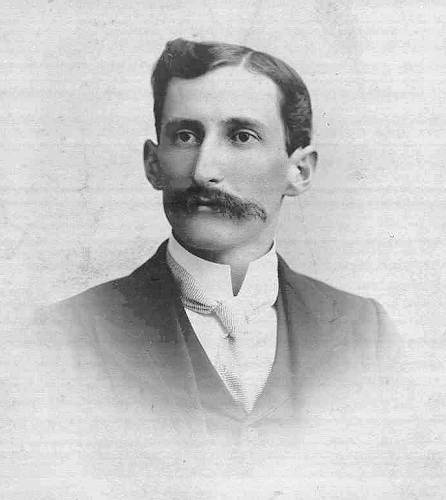
03 George Byron Smith
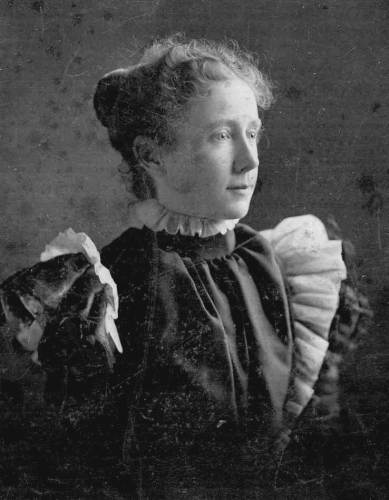
04 Mrs. George Byron Smith (Mabel) I have to write their story almost entirely from observations of their former students for I was too young to have had the privilege of attending their fine, upstanding school. I feel it was a big loss in my life that I was not numbered among the fortunate who did attend and graduate. Professor and Mrs. Smith were a young, newly wed couple just graduated from Knox College, when they decided to move to the Iberia community and attempt to organize a school for Higher Learning. They had a dream and a vision and today, their former students would most generously say, “Thank God for their fantastic Dreams and their Remarkable Visions.”
Their first term of school began on October 1 1890 with only one student in attendance. By the year 1931, the enrollment had increased to 85 students. The school could never boast of a large student body at any time, but it did produce fine young men and women who went out into the world and became nationally known and the Academy was always recognized as a very valuable institution of learning.
The first Normal School’s Main building burned in October of 1917. (I might add here that for years this school was referred to as the Normal School and today the street that borders it to the north is called Normal Street.) On May 28, 1919, ground was broken for a new Academic building which is the present structure standing on the campus today (photo 05).
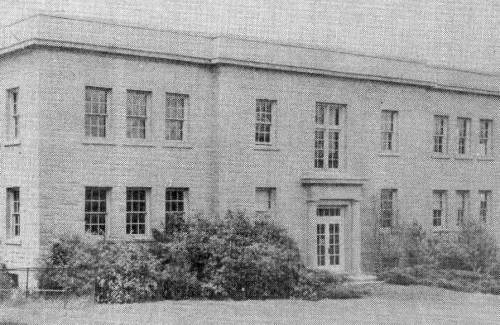
05 Iberia Academy Classroom Building In 1910, there were three buildings on the campus…the Girls’ Dormitory which is still standing, the Girls’ Cottage, which no longer exists and the academic building which burned in 1917 (photo 06).
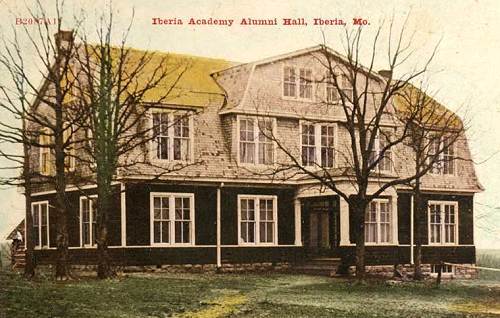
06 Alumni Hall Girls' Dormitory The old building consisted of five recitation rooms, a chapel, library, and both chemical and biological laboratories. Its library contained 6000 volumes of fine books an in 1912 over 1000 volumes were added. They had a herbarium with over 500 plants, ocean specimens, 300 microscopic slides, and necessary micro chemical reagents. Unfortunately, many of these items were destroyed in the disastrous fire of 1917. The school no longer exists today as an educational institution, but it still stands on the original ground where skilled hands constructed and laid the stones that shaped these old buildings and they seem to silently cry out to anyone who listens…”Please don’t ignore Me for I shaped the lives of Iberia’s sons and daughters; I prepared them for a world that was sometimes alien; but did they not succeed in their various fields? So when you pass by, please look upon Me with Pride and Respect.”
These lonely, but not forgotten, buildings have a special place in my life for it was the skilled hands of my Smith ancestors who cut, shaped, and then laid the rocks that formed these walls of stone. My great grandfather, Harrison Smith, taught his sons this necessary trade of stonemasonry and Frank “Cap” Smith, my grandfather and Felix “Pea” Smith, his brother, spent many long hours in the construction of these buildings and they also built the rock wall that surrounds the campus. I understand that some of the students of the school were given the opportunity to learn stonemasonry and they helped in some of the construction also.
Note: you can read a complete history of the Iberia Academy written by Peggy on our website.
Early churches near the Iberia community were very few in number in the 19th century. The United Baptist Church of Christ in the Big Richwoods was one of the earliest organized churches in the area. In 1843, the Reverend Reuben Short, started this congregation and they met in a place called the Smyrna church house. They shared this church with a group of Methodists, but in time, their differences began to rise to the surface. So on March 6, 1858, the Trustees of the United Baptist Church (Reuben Short, James Bowlin, Pauline Gardner, Alvis Dunkin and William R. Wright) bought a one acre tract of land from Samuel P. and Mary Malvina Tucker to construct their own place of worship. In the deed it states that the one acre tract was to be used exclusively as a “place for Public Worship and a cemetery for the use and benefit of the neighborhood and to be kept expressly for that purpose.” One hundred and twenty one years later, it is still used for that purpose for the Iberia City Cemetery is located on the original site of the church although its first graves may be lost in obscurity.
Another early church whose history extends even farther back in time was the Disciples of Christ Church. It was organized approximately near the year 1835 by a man named Isaac Clark, whom I believe may have been a native of Greenup County, Kentucky. They also used the old Smyrna building for their services. This old log house certainly saw a variety of worshippers come through its doors in the years it existed.
The names of some of the early preachers in the Iberia area included Reuben Short, Abraham Castleman, Jacob Capps, Jehu Carnes, Thomas Owen Workman, Isaac Clark, David Henderson , Allen Henderson, Thomas Winfrey, J.W. Ritchey, Benjamin Hooker, Z.W. McCubbin (photo 07), John H. Davis, George Wilson, Joshua Cochran, T.T. Phillips, Charles A. Mayfield, J.D. Thompson, R.B. Cornett, and many more who ventured into a new century.
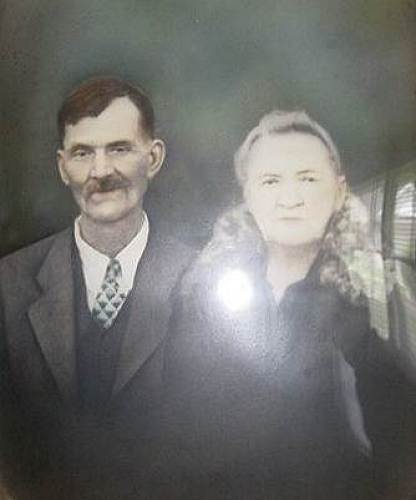
07 Zachariah and Eliza McComb McCubbin Many of these ministers were the rugged but enduring circuit riders who traveled through a life of hardship trying to bring the gospel into the wilderness.
The Christian Newlight Church was organized in the 1890’s and their first meetings were held in the G.A.R. (Grand Army of the Republic) Hall which is still standing on the original site today and is used by the Masons and the Order of the Eastern Star for their meetings. Some early pastors of this church were C.M. and Ned Sooter (photo 08) and John Aust, the father of Uncle Charley Aust and Aunt Sally Jones whom I remember so well as I was growing up in the Iberia area.
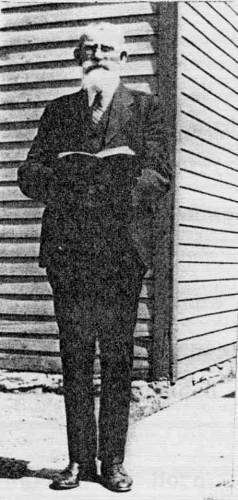
08 Charles M. Sooter About the year 1889, the members of the Newlight Church decided to build a place of worship and they acquired a small tract of land on the north side of Iberia and there they built their small church where it still stands today.
Note: you can read more about Charles M. Sooter, the preacher most important in the Newlight Movement on our website.
The Methodists have been in the Iberia area for a very long time. Before the Civil War era, they worshipped either in private homes or if the weather permitted, they held their meetings in the old fashioned brush arbors. They also shared the old log cabin called “Sulky” Church with the Baptists for a number of years. Their present church was built in the 1890’s.
The First Christian Church was organized about the year 1897. A traveling evangelist, J.D. Greer, ventured into the Big Richwoods that year from the Sedalia area and conducted a Revival Meeting in a grove of post oak trees that were standing on the old Holmes Farnham homesite. The lumber used to construct the platform and seats had originally been intended to be used in building a new saloon according to legend. The site of these outdoor meetings that had once been a wooded area are designated as a park on the Frank Lombar property. Mr. Lombar owned most of the land from the Farmer’s Exchange Super Market on southward to the Highway 17 intersection (photo 09).
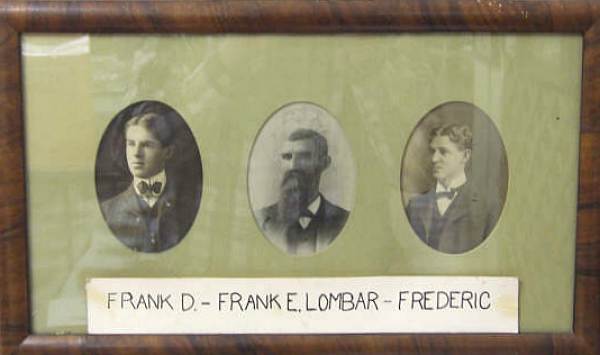
09 Lombar Family In the fall of 1897, the congregation elected to build a new church and they built on the present site which faces the old Iberia Academy on Normal Street. At one time it was also called Academy Street. Early pastors included J.D. Thompson, J.H. Thompson, and W.F. Jones.
Note: you can read more about the Lombar family on our website.
The Brays Union Church was begun in the 1870’s. For a number of years they met in private homes for their Christian fellowship and their first church was built in the time era of 1885-87. The site of the church was on an 80 acre tract of land owned by the Will Morrow family who were early members of this congregation. Other familiar family names who maintained the existence of this little country church were the Humphreys, Tylers, Newharts, Smiths, and Shepherds. They observed their 100th year in October of 1979 with a Heritage and Homecoming Sunday complete with an old fashioned basket dinner (photo of church).
Note: you can read more about the Brays Union Christian Church on our website.
The Hickory Point Baptist Church was organized in December of 1840. Reuben Short was chosen to minister to the folds for six months and upon his departure, the Reverend G.O. Morris was called to pastor the church. In April of 1842, the church had a membership that numbered 15 souls, and their first deacon chosen was William McCubbin. By March of 1843, they had added 27 new members of whom three were colored ladies and Z.W. McCubbin was their new minister. In 1845, the members voted to build a new church or meeting house and it was constructed about a 1\2 mile northeast from the present church site. Up until October of 1883, the church was known as the United Baptist Church of Christ, but on that date it was changed to the Hickory Point Baptist Church (photo 10).
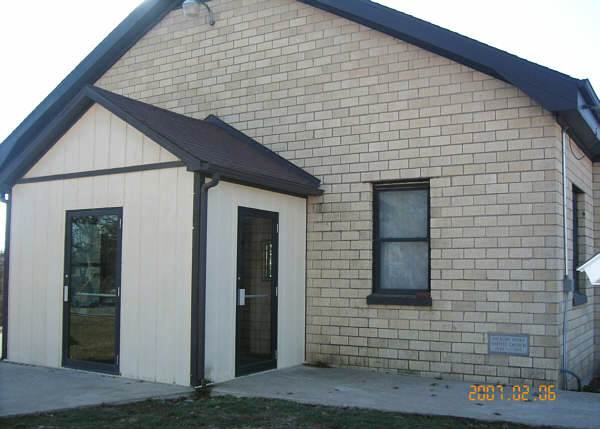
10 Hickory Point Baptist Church Note: you can read further about Hickory Point Baptist Church on our website.
Iberia’s Assembly of God Church is one of the newer denominations even though it has been 56 years since they first organized in 1923. Three men, George and James Hicks and Jerry Hancock purchased a tract of land from D.P. and Lillian Farnham on November 16, 1923, and it was on that small tract that the first services were held in an old, rundown building that was already there on the land. But finally in 1928, a new church was built and the members attended this church until in 1975, when their new, beautiful edifice was constructed northwest of Iberia on Highway 17.
The Congregational United Church of Christ had its beginning with small meetings in the years of the early 1870’s. Daniel Callahan was called to pastor the church in 1871. During the first 7 or 8 years of its existence, the congregation met at the I.O.O.F. (International Order of Odd Fellows) Hall and also in the Methodist Church, but in 1879, their first church was built and its pastor was the Reverend W.H. Hicks. The church was a participant in the Iberia Academy and Professor G. Byron Smith served for a good number of years as the church’s pastor. They celebrated their 108th year Anniversary in 1979.
On August 15, 1911, a one acre tract of land was conveyed to the Trustees of the Fairview Christian Church by Sarah E. Fancher. The three Trustees named were Samuel I. Burks, J.D. Brumley, and W.F. Hensley. The Church’s building was started immediately by all the people of the community donating their labor and one month later the first service was held in the new church, with the Reverend W.M. Sooter preaching the first sermon. The Church of the Nazarene was organized in August of 1925 after a successful tent revival that was so popular in those days. Their first membership numbered eleven people and had increased to 24 in a short time. Their present church building was dedicated in September of 1949 and its steeple stands so majestically against the horizon with a cross that lights the sky at night. It is constructed from 130 tons of red granite rock that was mined and cut in Iron County, Missouri, My grandfather, Frank “Cap” Smith and his brother Felix “Pea” Smith also laid these granite rocks that shaped this beautiful stone structure.
On October 19, 1878, Mahala Keeth deeded 2 acres of land to the Trustees of the Pleasant Hill Christian church in Section 10, Township 38, Range 13, but the trustees were not identified in this Warranty Deed. A small church constructed of logs was already built on this site in 1878, so I do not know for sure when it was organized. Some of the early families represented as members of the Pleasant Hill Church included the Keeths, Whittles, Sheltons, Adams, Longs and Sloans. The oldest grave found in the church’s cemetery is recorded on a stone with the name P.J. Long who was buried in 1885, but I am sure there are older gravesites that are unmarked and lost in obscurity. The Pleasant Hill Church was the site of a murder that occurred in 1886. Charles Adams Jr. And two Whittle brothers, Robert and John, became engrossed in a confrontation outside the church that involved a young girl. When the fight was over, John Whittle lay dead of a gunshot wound from which he had died instantly. In April of 1887, Charles Adams Jr. was convicted by a jury of 4th degree manslaughter and was fined $500.00. He had been indicted for murder in the 2nd degree, but his sentence was lessened to a 4th degree manslaughter charge.
The Negro population of Iberia in the latter 1800’s held their worship services as often as possible. They had to depend on a transient preacher to come through the area to conduct a Sunday service and sometimes one could stay long enough to hold an old fashioned revival in the old log schoolhouse one mile west of Iberia. There was an old Negro preacher called “Preacher Brasco” who frequently passed through the area and one night in 1903, he preached a sermon to the white folk at the Baptist Church. In the years after the turn of the century, William M. Driver, a Free Will Baptist, whom many called “Preacher Bill Driver,” ministered to the Negro population. They were a joyful, happy group of people who used stringed musical instruments in their worship services.
In the year 1874, there was a publication in print called “Campbell’s Gazetteer of Missouri” written by a man named R.A. Campbell. In it, I found a section written about Miller County concerning its history, physical features, agricultural productions mineral resources; its wealth (which was estimated at $2,100,000.00 and was completely debt free) and a list of towns of the county. The following was written about Iberia in that year of 1874:
“Iberia (Oakhurst) 10 miles from Crocker, its nearest railroad station, and 16 miles southeast of Tuscumbia, was settled in 1856; is located in a wealthy district, and contains a church, Masonic hall, 4 stores and 1 saddler shop.”
So, Iberia was a very small village in the early 1870’s with only one church listed which must have been the “Sulky” Baptist Church which was built on the present site of the Iberia Cemetery. All other churches were not built until after 1874.
The town of Iberia was incorporated as a city in 1875. The first town board consisted of Mr. Frank Lombar, a merchant; George Johnson, a blacksmith; Isaiah Latchem, an attorney; Dr. Jesse B. Smith, and James S. Martin. Other men instrumental in getting the city incorporated were Dr. John H. Moore, Dr. S.P. Hickman (photo 11), Felix B. Gardner, who owned a hack line; Joseph and John Humes who were blacksmiths in the Iberia area.
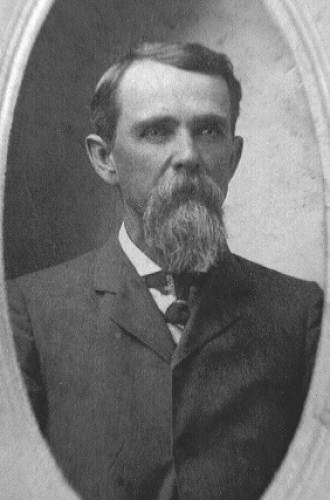
11 Samuel Peter Hickman, M.D. Note: more can be read about Dr. Hickman on our website.
In the year 1862, a Circuit Court case was filed that involved the land where Iberia sits today. The old site of Iberia may have been in jeopardy at that time and the course of her history could have made a drastic turn. A lady named Rebecca Ludwig, who lived in Rolla in Phelps County, brought a suit against five men who were land owners in the Iberia area. The defendants named in the case were Henry M. Dickerson (who had already platted the original town of Iberia); Mathias Noyes; Henry Brockman; James Long; and William Hoskins. She stated that they owed her $400.00 plus interest at the rate of 10 per cent annum which they borrowed in 1860. Each of the men was presented with a summons to appear in court on the 4th Monday of October in 1862. The Sheriff of that day, Thomas Tompson, presented each man a copy of the summons, but on October 29, 1862, the day of the trial, none of the five men made an appearance in the courtroom. The Judge awarded Rebecca $462.90 plus court costs in the suit, but apparently none of the men would pay their part and Sheriff Thompson conveyed 140 acres of land that he had seized to a man named Jackson Coggburn. These 140 acres included much of the area that Iberia entails today. Mr. Coggburn bought this 140 acres tract of land for $660.00 in September of 1867.
In October of 1874, Jackson Coggburn who was residing in Cole County, Missouri, sold the majority of the 140 acres to Frank and Mary Lombar who had just moved into the Iberia area from the East Coast. Frank was a native of New York State and he came into the Big Richwoods with enough ready cash to buy up this very important piece of land and at the same time he opened up a Dry Goods Store. The Lombar’s proceeded to subdivide this acreage and add it to the town site of Iberia. First came Lombar’s Division; then they platted Lombar’s First Addition; and finally Lombar’s 2nd Addition. This entailed most of the land lying south and west of the original town platted by Mr. Dickerson in 1859. Frank Lombar began to sell off lots and blocks of his plats and some of the families who bought his land included the surnames of Farnham, Benage, Kellison, McCubbin, Perkins, Irwin, Wagner, Groff, Carroll, Durham, Latchem, Baker and Thompson. In my estimation, Frank Lombar saved the town when he bought this land and had the foresight to subdivide and therefore increase the size of the village.
Note: more can be read about the Lombar family on our website.
In the span of years following the Civil War era, Iberia’s face changed many times…businesses came into existence and then seemed to disappear. Names once familiar no longer were in the town’s population. It was a strange transformation and one that is not easily researched. The earlier pioneers who homesteaded the surrounding area seemed to have moved on in other directions. The surnames of some of those early pioneers were Dyer, Lenox, Tucker, Castleman, Hoskins, Biggers, Blevans, Melton and Price. These are not familiar names today to our area. The following are some of the original homesteaders who still have descendants in the region bearing the family name: Bilyeu, Shelton, Burks, Allen, Gardner, Shackleford, Bailey, Aust, Musick ,Long and Wilson.
In the following section I will try to record some of Iberia’s former businesses and professions that have existed in the past 120 years. I suppose the first business for any pioneer area was a trading post and Iberia’s first one was called the Lenox Trading Post which I have mentioned earlier. Its livelihood was short lived for it was destroyed during the Civil War and was never rebuilt. The Blacksmith was an important and popular man to the population and as a rule, he generally served as a liveryman and wagon maker as well. Samuel Caulk was one of Iberia’s earliest residents although he actually lived about 1 ½ mile southeast of town on land that is owned today by Robert Perkins. He purchased 80 acres of prime land from Cornelius and Malinda Bilyeu in 1852. He was a blacksmith by profession and he set up his livery and blacksmith shop under trees that stood on the north corner of St. Louis and Main Streets which is the exact spot where Iberia’s City Hall stands today. It later passed into the hands of Thomas Garner (photo 12) and he sold it later on to J.S. Casey (photo 13). Mr. Casey sold the lot to the new Bank of Iberia in 1899 when they established Iberia’s first bank in that year.
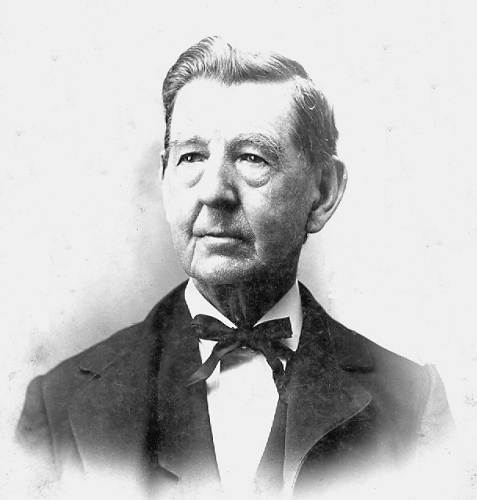
12 Thomas Durham Garner
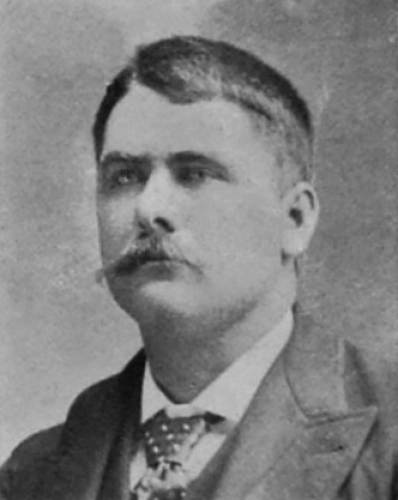
13 John S. Casey Other blacksmiths who have lived and worked in Iberia are John and Joe Humes, James Smith, J.C. Thompson, Rector Thompson, J.D. Rowden, George Johnson, Franklin Roark, James R. Sloan and John Hayes, a Negro. Elijah Dyer was probably Iberia’s first merchant. He had a store in his home in 1840 and other early merchants included Jesse W. Burks, Samuel Short, Samuel P. Tucker, J.H. Branham, Haman Dyer, Mark and Isaac Lesem, Henry M. Dickerson and Matthias Noyes. By the 1870’s new merchants were on the scene…Frank E. Lombar and Thomas D. Garner of Tennessee had moved into the Iberia area and opened Dry Goods Stores…Boot and shoemakers known as “tanners” were Saul P. Tucker of Kentucky and Jacob Gardner, a native of Barren County, Kentucky…Wagon and harness makers were Joseph Hume of Tennessee and William F. Burks from Illinois…Hotel operators were James H. Rowden who was from Maries County to the east and Zachariah Bourne owned a wayside inn for travelers…John D. Brown was a carpenter and a furniture maker…Marcus Fancher was a grocery merchant and Frank Fancher also worked in the store as an apprentice…John Clark, a native of Ireland, lived in Iberia and was an engineer by trade…Mrs. Isabelle Furgeson who was a Scottish lady, lived on the outskirts of town and was an experienced seamstress…Jeremiah Whalen owned a brick kiln in the 1890’s and produced many stones that were used in the construction of new buildings. Stonemasons included William Harrison Smith and his brother, John Wesley Smith who were born in neighboring Camden County to the west. Early postmasters were Frank Lombar, Elijah Dyer, Samuel Short and Wilson Lenox. Early mail carriers who carried the mail on horseback three times weekly were Wiley Gardner who had the Dixon Atwill Store Brays route, Manessah Jones (photo 14), A.M. Jones, and Felix B. Gardner.
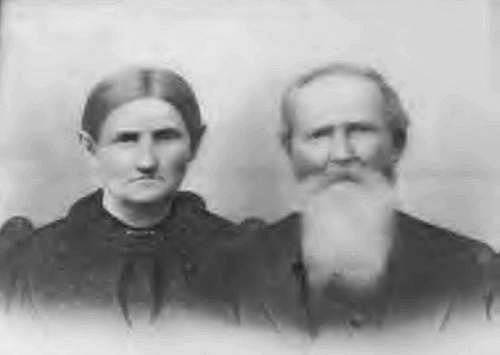
14 Manessah and Margaret Jones Note: Of these many illustrious early figures in the History of Iberia mentioned above by Peggy, Thomas Garner stands out (see photo 12 above). You can read more about him on our website.
Early physicians in the vicinity included Jesse B. Smith, a native Missourian born in 1826; a Dr. Mitchell who served the populace in the 1860’s; Dr. H. John Moore from Virginia was a druggist (photo 15).
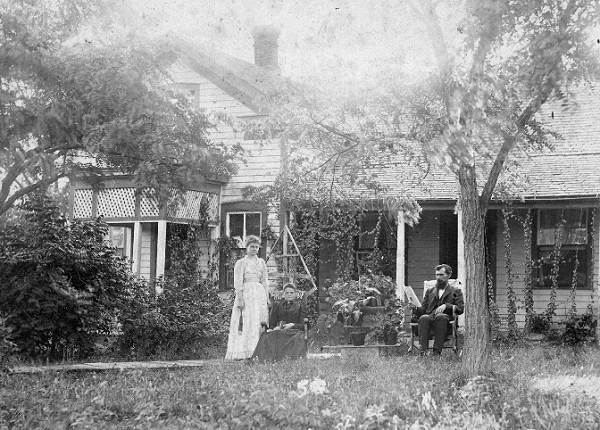
15 Estella Moore, Alice Catherine Fancher and Dr. Harry John Moore Other names found in old records are John L. Short, J.W. Wade, D.A. Lynch, George A. Mace (photo 16), J.L. Benage, S. L. Baysinger, George W. Curtman (his father was Dr. Charles O. Curtman, a native of the Grand Dutchy of Hesse, Darmstadt of Germany, who practiced the medical profession in Osage township near St. Elizabeth for 2 decades prior to the Civil War and in the 1860’s he moved his family to the St. Louis area); A.P. Nixdorf who was a native of Prussia and S.P. Hickman (photos 17 and 18).
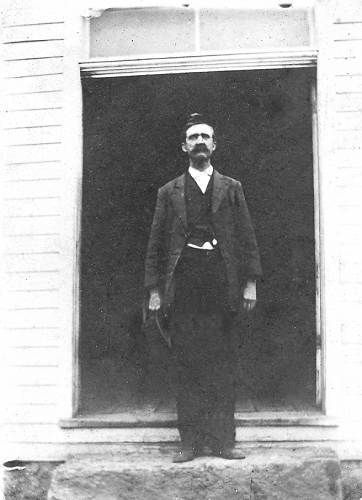
16 Dr. George Mace
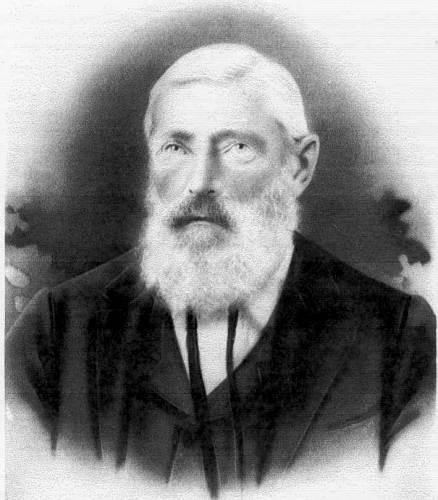
17 Anton Paul Nixdorf, M.D.
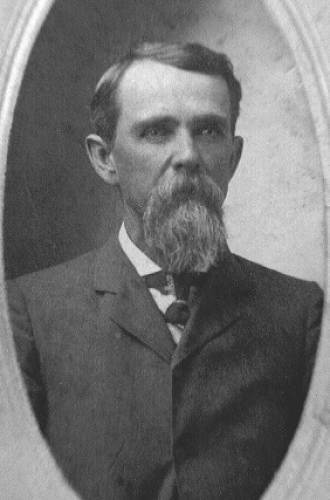
18 Samuel Peter Hickman, M.D. Note: Of the above physicians you can read more about A.P. Nixdorf, George Mace and Samuel Hickman by clicking on their names.
Lawyers were not very prevalent during these years but there were at least two that I have found record of: John L. Arnold and Isaac Latchem.
Julius Bailey and Murrel (Merlin) Shackleford, both natives of Barren County, Kentucky, were partners in a General Store that sat on the present day home site of Mrs. Earl Kinder.
Benjamin Franklin Fike owned a fruit farm about 4 miles southeast of Iberia and he moved into town where he opened a general store and a restaurant in a large two story home sitting on the land where the Nazarene Church and parsonage is now standing. He bought this home from a man named B.F. Pittman who had built the home after purchasing the land from the trustees of the Methodist Episcopal Church. Other general storekeepers were John S. Casey and Miles J. Davison.
In1885, the “Commander of the G.A.R. (Grand Army of the Republic) Post was Jeremiah C. Tallman (photo 19). A very interesting fact I learned about Mr. Tallman concerned the general election of 1868. That was the year the General Ulysses S. Grant was re elected as our Country’s president and Jeremiah (Jerry) Tallman ran for two Miller County offices….County treasurer and County Probate Judge. He was elected to the post of Probate Judge but I am not sure that he ever served as County Treasurer.
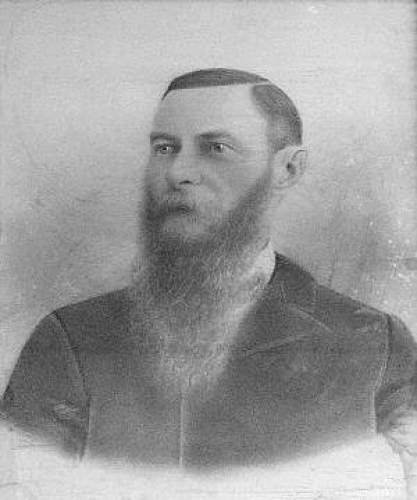
19 Jeremiah Tallman The Secretary of the Miles Carroll Post Number 3 of the Masonic Lodge in 1885 was Squire John Ferguson (photo 20). Squire Ferguson, a native of Scotland, was one of Iberia’s most colorful figures in her history.
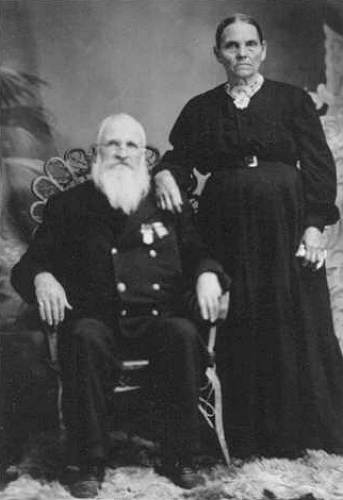
20 John and Dorcas Ferguson He was born in 1838 in Dumfries, Scotland and at the age of 14 came to America with his parents and two sisters on the ship called “Colonel Cutts.” His father died on the voyage and was buried at sea. The ship landed in the port of New Orleans in 1852 and the family sailed up the Mississippi River until they reached the city of St. Louis where they stayed until 1861. He came into Miller County in September of 1861 where he acquired work on a farm about 6 miles west of the town of Iberia and in 1862, he married Miss Dorcas Shelton who had lived in the region for quite some time. Squire Ferguson was a prominent figure in the Civil War era with many experiences that he was able to relate to his interested listeners when he was interviewed shortly before his death. He also served as a Justice of the Peace in the Iberia area for over 40 years.
Iberia has had four other newspapers prior to THE NEW IBERIAN. The first was called “The Iberia Advocate” and the editor and owner of the early newspaper was Charles Lohman. Its first edition ran in 1885. In 1893, another paper was formed under the name of “The Iberia Intelligencer” but it was not a success and was not on the scene very long. In 1898, Dan Fraser Thompson (photo 21) started a small local publication called “The Iberia Impetus” and it was in existence for about seven years.
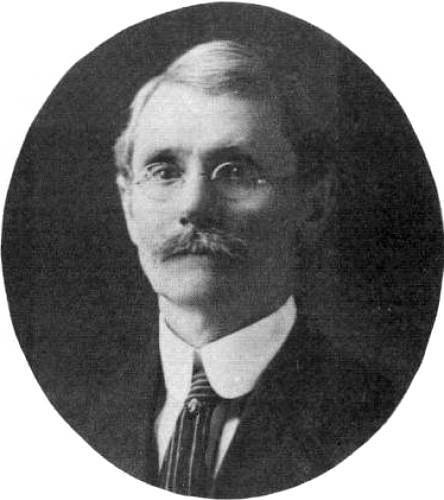
21 Daniel Fraser Tomson In 1905, George Martin (photo 22) began the “Iberia Sentinel” which was Iberia’s most popular and successful newspaper and it survived through many years.
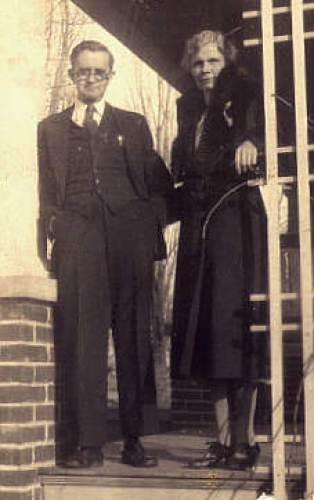
22 George and Laura Martin Before its demise, George Martin’s son, Glenn, took over the helm and served as the Sentinel’s editor for quite a number of years.
On further research I learned that Jerry Tallman, a native of Williamsport, Pennsylvania, served three years as a deputy sheriff; twice was elected as a Judge of the Probate Court, and was elected three times as Miller County Treasurer. So, he was certainly a well known man in Miller county politics.
Old water powered mills have been on the Iberia scene for along time. Before 1880, there were several mills in existence of which two were called “The Old Herald Water Mill,” and the Wheeler Mill. The Old Herald Water Mill gave its name to the heavily traveled road in those days and it was known as the Herald Mill Crocker Road. Thomas D. Garner and his son built the Iberia Roller Mills but it was destroyed in the 1890’s when the boiler, in a low water stage exploded and caused a great deal of damage. The most famous mill of all was the Old Brays Mill located about 3 miles east of Iberia. It was first erected by a man named James Rowden in the mid 1850’s. In 1860, Mr. Rowden sold the mill to a Mr. Wheeler and the operation was turned over to two German immigrants by the name of Goodmann and Lampe. In the latter part of the 1860’s, the mill was purchased by Tom Bray. He also owned the Pay Down Roller Mills over in neighboring Maries County near the small river town called Pay Down. In 1877, Albert Arendall, also from Pay Down, moved over and took over as manager of the Old Mill. In 1889, Tom Bray erected a second roller mill and it is still standing on the same spot today. It is an old huge four story building. The water wheel no longer turns, but it is still there sitting quietly on the north side of the old building. There has been some renovation work performed on the old structure by the present owners, but hopefully someone, someday, will preserve this old historic landmark (photo 23).
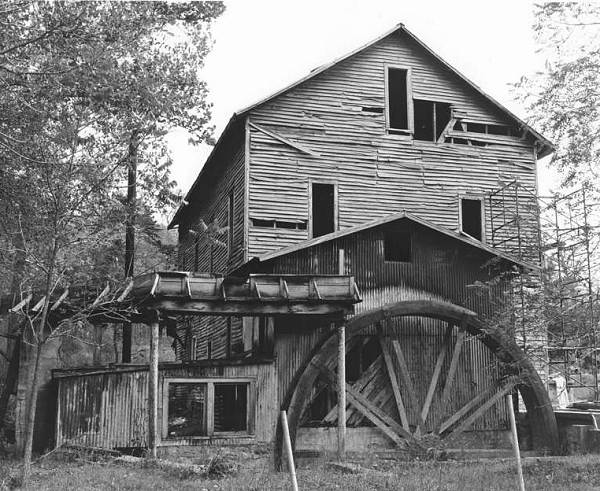
23 Bray's Mill In the year 1890, Frank and Mary Lombar sold a parcel of land to the Trustees of the G.A.R. (Grand Army of the ‘Republic) Miles Carroll Post Number 3. It was Lot 1, Block 2 of Lombar’s First Addition and they built the two story building on the triangular lot where it still stands today. The Trustees of the Post in 1890 were Charles P. Myers, William A. Thompson, Thomas J. Marchant, A.L. Benage,and Manessah Jones. Today, the building is used by the local American Legion Post.
In 1882, Iberia had a local lodge belonging to the Independent Order of Odd Fellows known as the I.O.O. F. In that year a quit claim was given to the Trustees of the Lodge who were Albert A. Arendall, E.C. Thompson, and Manessah Jones, for a tract of land where their Hall was to be constructed. It was located near the spot where the old Farnham Store is standing. The joint owners of that particular piece of land in 1882 were the Charles Martins; the Frank Lees; and the John Fergusons. Trustees of the Lodge in 1895 were Felix B. Gardner, M.J. Laws and Manessah Jones and in the year 1908 the Trustees named were George W. Adams and Henry H. Dickerson.
Iberia once had a Canning Factory on the corner of Main and Thompson Street. In 1906, George and Barbara Osborn sold a small parcel of land measuring 120 ft. X 120 ft. to the Directors of this Canning Factory. They also gave the factory permission to run a 2 inch pipe into the well adjoining the property to be used in the maintenance of the building. It was in existence for 17 years and in 1923, the Board of Directors who consisted of S.J. Heltzell (photo 24), J.K. Groff, and W.A. Dickerson sold the factory and land to a Mr. Charles J. Meyers who was living in Webster County, Missouri for the total price of $1000.00.
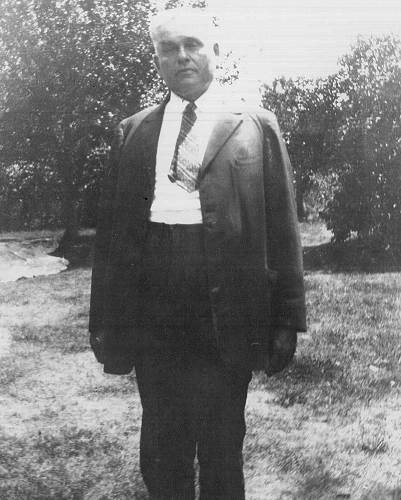
24 Selby John Heltzell It was situated in the area where Dr. Gould’s home and medical office is now located.
In January of 1908, the Iberia Mill and Electric Light Company was organized. It was located on land sold to the Company by Miles and Electa Davidson and included Lots 1, 2, 3 and 4 in Block 3 of Lombar’s 2nd Addition to Iberia. The Mill faced Thompson Street on the west and Benage Street on the south and it was directly behind the old Iberia Elementary School. They piped water into the building from a large spring that was directly east of the Mill. The capital stock of this Mill and Light Company amounted to $9,000.00 and was divided into 90 shares. The Board of Directors were C.W. Farnham, President; J.L. Irwin, Vice President; Frank Topping, Secretary; John S. Casey, Treasurer; and other Board members included Miles J. Davidson, D.P. Farnham, and W.A. von Gremp. It is no longer in existence but I remember the huge, old building standing there in the 1940’s when I was a student at the Elementary School.
On July 11, 1906, a telephone franchise was voted upon and was passed by a two thirds majority vote by the citizenry of Iberia. The Telephone exchange’s Company Directors included J. L. Benage, H. M. Garner, Walter Morrow and G.M. Durham, who was the Chairman of the Board. The franchise was ratified on the 30th of July in 1906 by a local vote once again by the people of the village of Iberia.
Iberia’s first bank is still her only bank…The Bank of Iberia. It was organized on October 20, 1899 with its first President, John S. Casey followed by Miles J. Davidson and John L. Irwin. The land was purchased in September, 1899 from John S. Casey and his wife, Martha, and it was Lot 2 in Block 5 in the original town of Iberia. It stood on the northeast corner of Main and St. Louis Streets, measuring 50 ft. X 60 ft. where today’s City Hall is situated (photo 25).
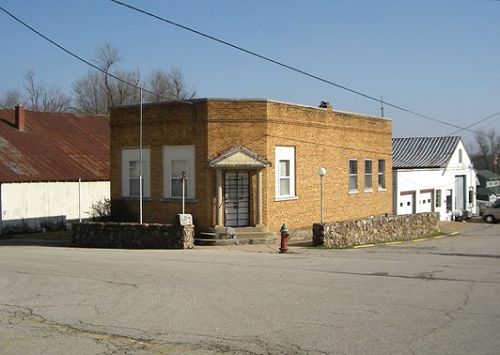
25 Bank of Iberia The bank celebrated its 80th year in 1979 and is now sitting on Lombar Avenue in its fine, modern home (photo 26).
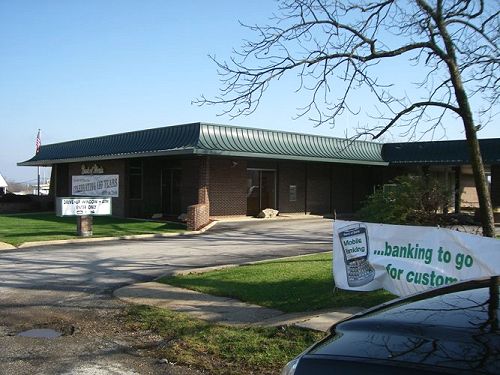
26 Present Bank of Iberia The site of the new building is on the original home site belonging to Frank and Mary Lombar where they lived for many years after moving to Iberia from New York in the early 1870’s.
Iberia had a second bank that was incorporated on May 28, 1907 with its capital stock amounting to $15,000.00 and divided into 150 shares. It was named Farmer’s and Trader’s Bank and the first Board of Directors included J.K. Groff, its first president; J.R. Bond, J.C. Hensley, J.T. Hensley, J.V. Musick, J.E. Ramsey, J.L. Prock, Thomas Doubikin (photo 27) and J.D. James (I have a complete list of all shareholders and the number of shares each owned).
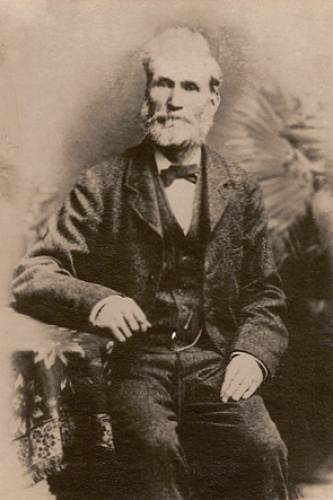
27 Thomas Doubikin The land was sold to the Bank by G.M. and Alceria Durham and the building was constructed on Lombar Avenue. The Wayne Barnett Store is now occupying the old building. It was opened for business in the year 1907 and existed until 1934 when the Missouri Commissioner of Finance seized the business and the property of the Farmers and Traders Bank. In 1937, the Commissioner conducted the sale of the building to Jackson D. Thompson, Jr. where he kept a small business in the building for a number of years. I remember as a child that Uncle Jack Thompson (as he was called) had an ice cream and candy store in the old building and I also believe he had a mini delicatessen on the premises as well. I can only vaguely remember how the store appeared in those early years of my childhood.
In the year 1905, the town consisted of a post office which was located on the corner where the drug store sits today; three churches…the Methodist, Congregational and the Christian New light; the old Normal School which later became the Junior Academy; 2 G.A.R. Halls that are still standing in the same spot and a livery stable that was located Lombar Avenue near the entrance to Normal Street. There were at least 26 homes in the city limits and some of the landowners in the town site that year included: F.B. Garner, George Robinson, Felix Smith, W.T. Hedge, M.E. Clark, Mary F. Jacobs, Thomas H. Fancher, W.C. Martin, J.A. Capps, L. F. Atwill, J. Jones, George M. Martin, B.F. Groff, H.F. Carroll, D.P. Farnham, Felix B. Gardner, Mary E. Wright, John S. Casey, J.W. Whaling, George A. Osborn, Frank E. Lombar, W.A. von Gremp, Bettie Lollis, Ester Schell and F.R. Craig.
Before the turn of the century there were several small settlements surrounding the Iberia general area and each had a post office but today none have survived. The following are those I have found and where they were located approximately: Faith, (southwest of Iberia); Watkins, (northwest); Brays, (east); Atwell, (south east); Claxby, (north); Caenby, (northeast); ‘Ramsey, (north); Blyze, (northeast); and Sudheimer, (southeast). There may have been others that I failed to locate in my research.
I am sure everyone is familiar with Iberia’s old jailhouse that stands to the back of the Nazarene parsonage (photo 28).
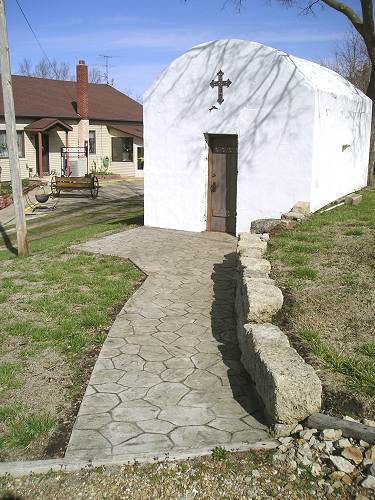
28 Iberia Jail I wanted to include its history in the town’s history for I am sure its walls could tell many interesting stories if only they could speak. In 1908, David and Henrietta Farnham deeded the Trustees of the Town Board a small parcel of land containing one quarter acre to be used for the construction of this jail. It hasn’t been used for a long time, but it is almost 75 years old and it will stand as one of Iberia’s historic landmarks in the years to come.
Fourth of July picnics for many years were held in the Hardy Lollis Park that is located to the back of the local Shell Service Station. Hardy and Bettie Lollis were a black couple who had owned this land for many years following the Civil War times. I can remember as a young girl that many summer picnics and carnivals were held there and it was always referred to as the Hardy Park. My grandparents, Frank and Eliza Smith once lived in a small frame and log house that sat on this land about 40 years ago. I can remember the area around where we children played…a small stream that ran through the land on the north side; the wooded area; the hills; the hollows; it was a beautiful spot and today the beauty is still there.
Iberia had a bandstand at one time also. In the 1890’s there was an old well located in the middle of Lombar and Main Streets (today’s Highway 42) and a small bandstand was constructed over this old well. The folks of the town were entertained by a local band directed by H.M. Garner (photo 29) and they played the old country folk tunes as well as the patriotic songs of their day to the delight of the young and old alike (photo 30).
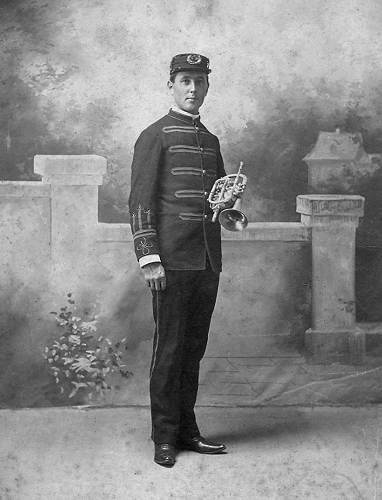
29 Hugh Garner - Director of Iberia City Band
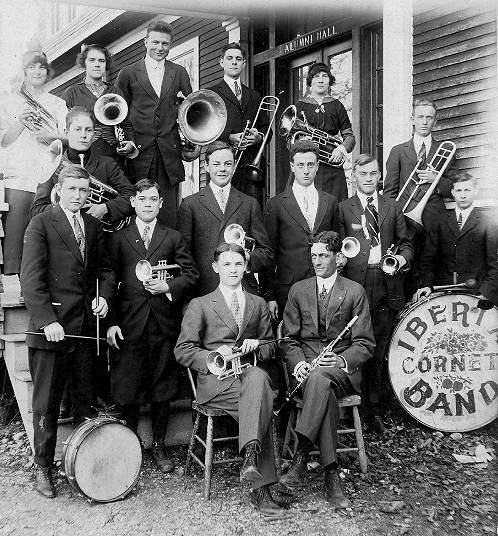
30 Iberia Cornet Band - 1915 - Director Hugh Garner On October 15, 1921, H.F. and Hannah Carroll sold a tract of land measuring 85 ft. X 95 ft. at the corner of Lombar and Pearl Streets to the Board of Directors of the Iberia Cooperative Association No. 208. A large two story frame structure was built on this corner and in 1941, a Certificate of Amendment was presented to Missouri’s Secretary of State and when it was approved, the Iberia Cooperative Association No. 208 became known as Iberia’s MFA Farmer’s Exchange, which is still progressing strongly today at a new home, but on the same parcel of land they acquired in 1921.
Though Iberia is a small community, she has Divisions and Additions that have been platted to the town. Frank and Mary Lombar were the first, as I mentioned previously, to sub divide lots and blocks out of the area of the original town site. In October of 1890, they legally recorded their first plat, Lombar’s First Addition, at the courthouse in Tuscumbia. On the same day, Felix and Sarah (Hume) Gardner recorded their first plat and called it Felix B. Gardner’s Addition. These were followed by Thomas Garner’s First Addition in 1892; Lombar’s Second Addition in 1893; George Johnson Addition in 1893; Thomas Garner’s Second Addition in 1895; R.L. Hayes Addition in 1916; and onward into the modern day plats of Jones Additions and Perkins Additions No. One , Two, and Three. When these Additions were approved by the Town Board of Trustees with a duly authorized Ordinance, then the owners of the lands proceeded to dedicate the avenues, the streets, the alleys, and the commons to the public’s use.
It was the springtime of 1939 that Iberia experienced her devastating holocaust of fire. My memories of the fire are so clouded for I was only four years old. It is as though my mind can capture only brief hazy scenes of the flames, the smoke, the milling crowds. The date was April 22, 1939, a quiet Saturday evening when a gasoline truck pulled up to a gas pump at the Lev Adams Produce Company sitting on St. Louis Street where the Law Oil Company is situated today. The driver was delivering a new supply of gasoline and without thought of impending danger, a match was lit and it accidentally ignited the gas fumes and an enormous flame spewed forth. The Adams Produce Co. immediately became engulfed in flames and the driver of the truck tried to drive his truck from the scene. He drove as far as the location of the old Iberia High School and the flames were following him closely because gas was pouring from his truck. He got out of his truck without injury and by this time the fire on Main Street was spreading wildly. The business places lost before daybreak included the Bank of Iberia; Adams Produce Company; a garage sitting to the back of the Bank; Adams and Casey general Store; Oscar Wilson’s Grill; Dr. Gould’s medical office; Earl Kinder’s Grocery and Meat Market; an old machinery shop; Glawson’s Shoe Shop; Wes Condra’s Barber Shop; Mrs. Groff’s Hat and Millinery Shop; and a large, 2 story home owned by the Lee Atwells. The Atwell home was sitting directly to the back of the area where Kinder’s Market and Adams and Casey’s Store was standing. Iberia did not have a water system in 1939, so the citizens of the town had to form a bucket brigade and saved as many buildings and homes as possible. The fire was confined to the north side of Main Street and the joint effort of the towns’ people saved the entire town from being consumed in flames (photos 31 and 32).
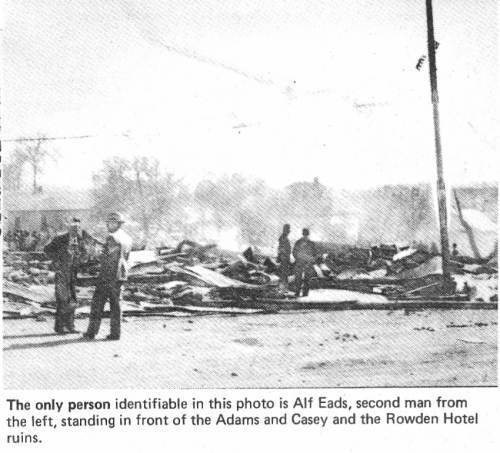
31 Iberia Fire - Alf Eads in front of Ruins
Click image for larger view
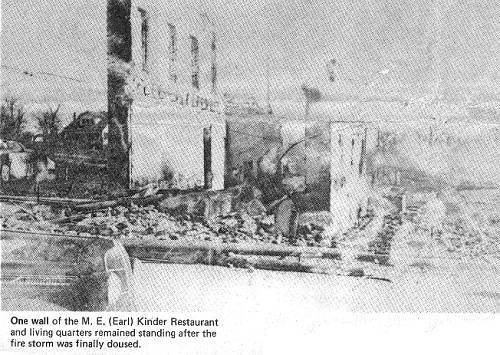
32 Iberia Fire - Earl Kinder Restaurant
Click image for larger viewIt was a disaster in every sense of the word, but a new town soon arose from the ashes much like the legend of the ancient “phoenix bird.”
As I bring Iberia’s history toward its conclusion, I feel I must devote this last paragraph to the name she has known for so many years… Rocktown. I have heard several different version of how and when she acquired this nickname. One story is told that during the Civil War there was a skirmish that occurred outside Iberia’s Fort and when the two sides opposing each other ran out of ammunition, their tempers continued to flare and in anger they continued their fight by throwing rocks at each other. Judge Jenkins related a different version in his “History of Miller County,”….a young Black Republican (a title attached to anyone who had voted for Abraham Lincoln) came into town walking beside his ox cart loaded with grist for the local Mill. His ox cart was equipped with rocks he had placed between the barrels of meal and when one of the young ruffians of Iberia decided to scare him with his gun, the young Republican quickly knocked him to the ground with a very powerful accurate throw. Others joined in the fight but the young man with his rock equipped ox cart stood off the attack and like David of old, he won out his battle with the Iberia Goliath’s. He left town proudly; the barrels of meal safe and secure; his team of oxen unharmed and apparently none the worse for his adventure.
Epilogue:
Compiling the history of Iberia has been a very enjoyable endeavor for me. She is my hometown, the town that I can recall with such pleasant memories and the home place of my happy childhood.
Her face has changed countless times through the many generations since the Indian roamed the rolling hills surrounding the present site. She had known good times, bad times, happy times and sad times. She has survived through devastating eras when Civil War nearly ripped her apart at the seams. She survived when the country was on the edge of ruin in the years of Depression. She survived when a disaster nearly leveled her in flames. She survived when her sons had to leave to serve in two World Wars. She survived when the urban areas of our cities beckoned the young people to move away and find better jobs….so, Iberians, both former and present, be thankful she had prove to be a survivor and not a fatality.
I could not have possibly written this history of Iberia without the assistance given to me by so many nice people. The list is so long, that I can not begin to name each one, but each of you will know that you were a part of this effort to present Iberia’s history. I hope that the older folks will remember some of these incidents that I have related with fond memories and the young folk will have a new and more prideful image of their home town.
Peggy Hake
November 1979
Thanks Peggy for your memories of Iberia and your research of its early history. The following photos of Iberia are placed here with their captions which are self explanatory (photos 33 - 47).
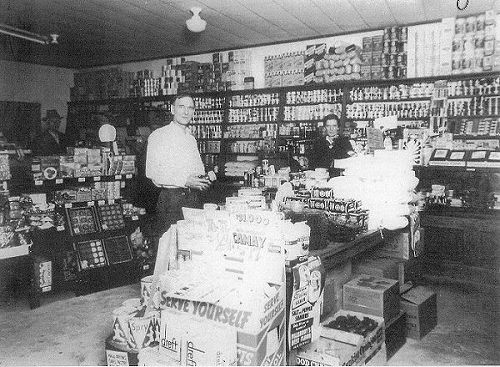
33 Earl Kinder Store - 1935
Click image for larger view
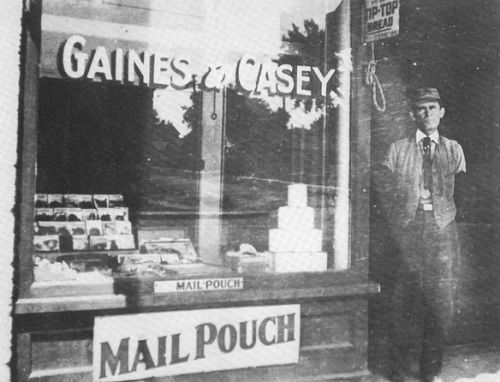
34 Gaines and Casey Store
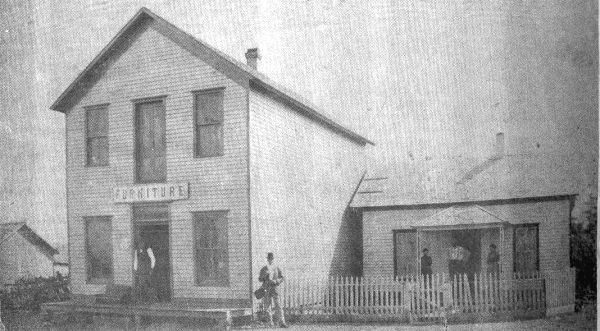
35 Farnham General and Mercantile Store
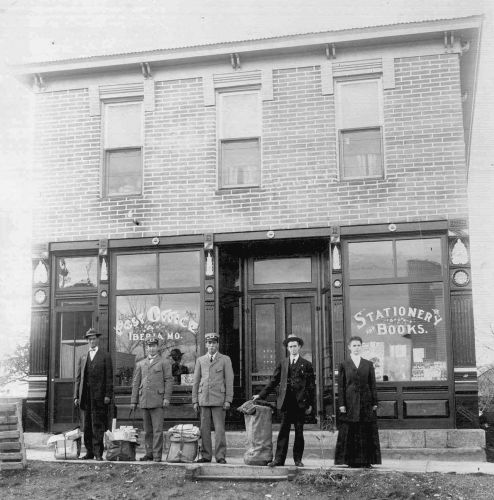
36 Iberia Hardware Company
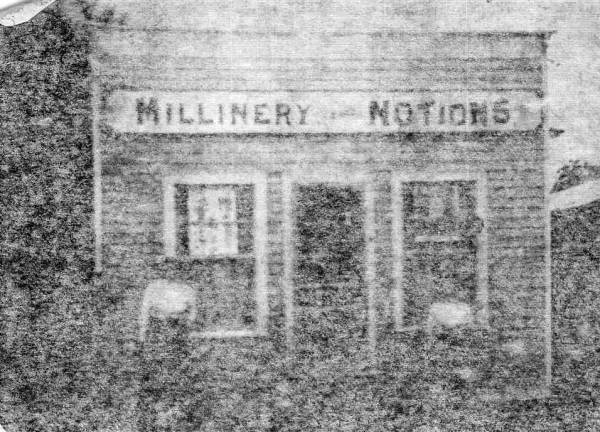
37 Iberia Millinery Store
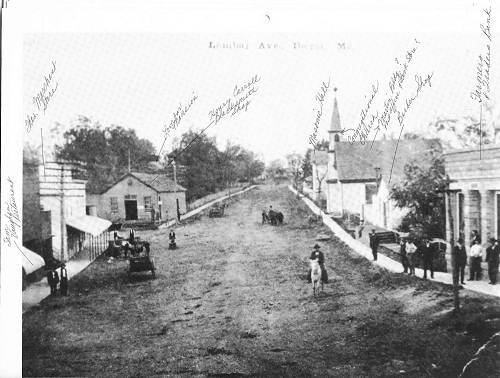
39 Lombard Avenue
Click image for larger view
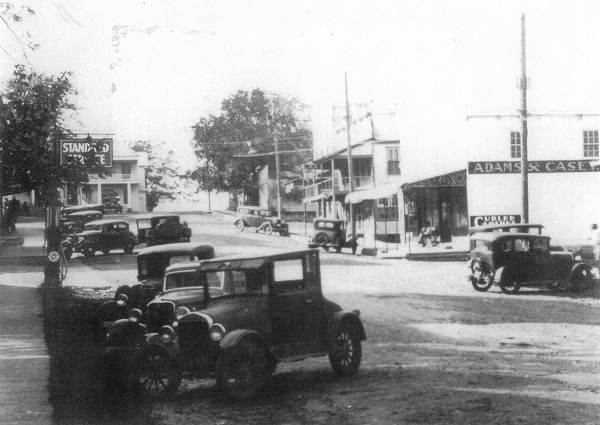
41 Main Street Looking Northwest
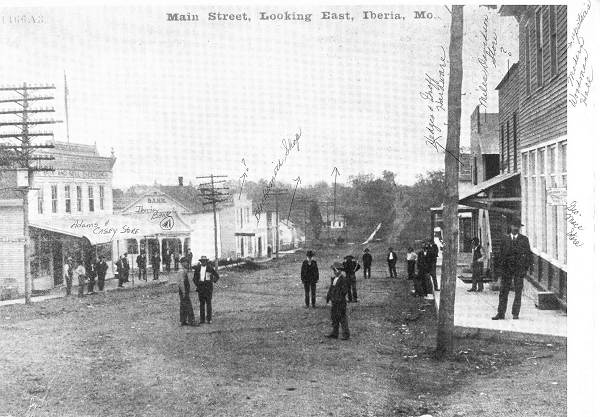
42 Main Street Looking East
Click image for larger view
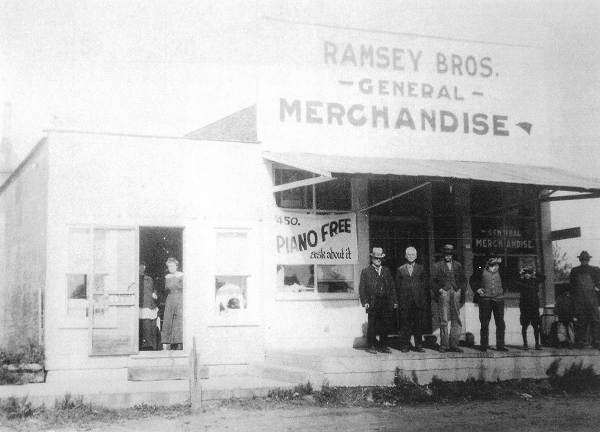
43 Ramsey Brothers Merchandise
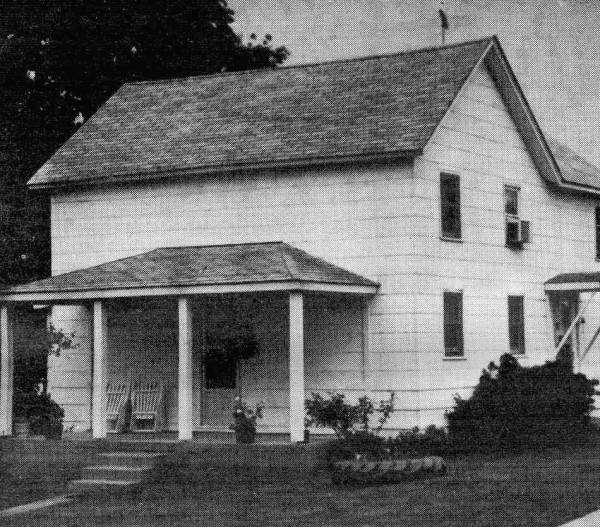
44 Rosell Pendleton House - Oldest Home in Iberia
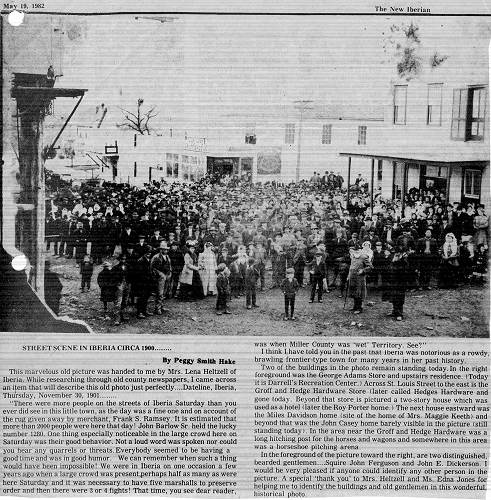
45 Iberia Street Scene - 1900
Click image for larger view
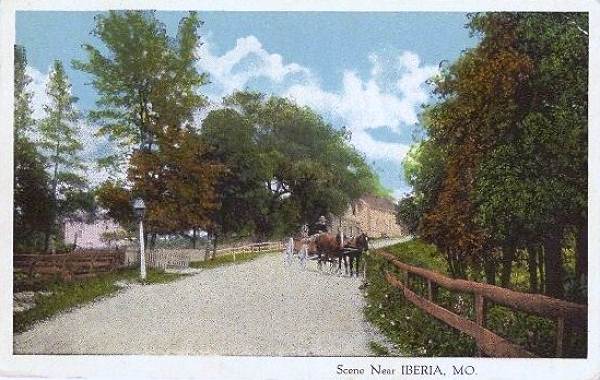
46 Scene Near Iberia
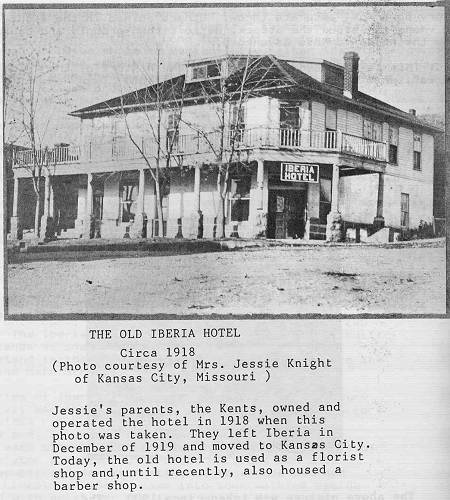
47 The Old Iberia Hotel
Click image for larger view
A couple of weeks ago the worst hail storm I have ever witnessed blew through the middle of the county from Lake Ozark over to D road and then crossed the river to devastate the Osage National golf course. It continued over to the areas of Rush, Cat Rock and Brown roads as well as Highway 52. The worst hail stopped just before reaching Tuscumbia. News of this terrible storm was covered by the local TV stations and newspapers. Many of you who subscribe to the Autogram or Advertiser newspapers read about the storm and saw some of the devastation in the photos which accompanied the articles.
My wife’s relatives’ farms were right in the path of the storm as it passed through the Cat Rock Road area. Her mother Elva Steen’s home and car were severely damaged. Two large windows on the east side were completely knocked out and had to be boarded up (photo 48).
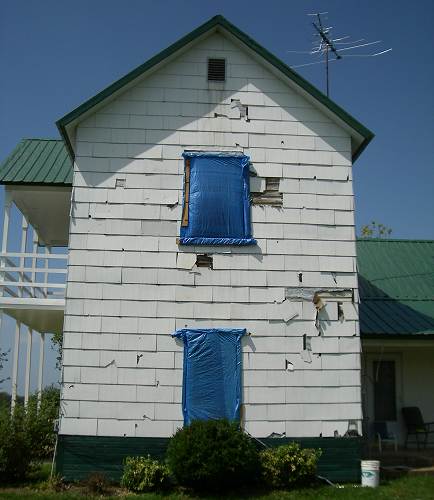
48 East side of Home Closeup The hail and rain which came through the upper window soaked about twelve of her hand made quilts which she had stored spread over each other on a bed. She had to find room to spread each one out individually to dry (photo 49).
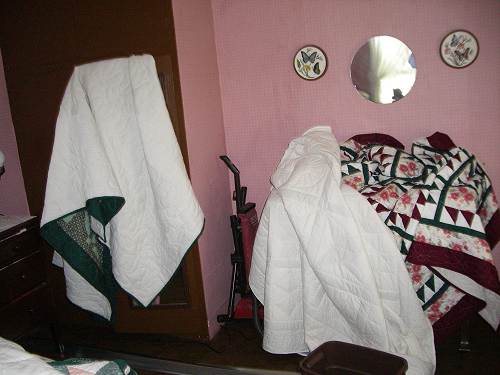
49 Drying Quilts The siding on the house was torn off in many places and the roof was indented in multiple areas by tennis ball sized hail (photo 50).
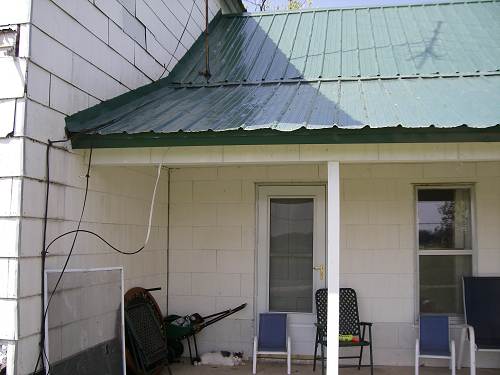
50 Roof Damage Tennis ball size holes were torn through several of her window screens (photo 51).
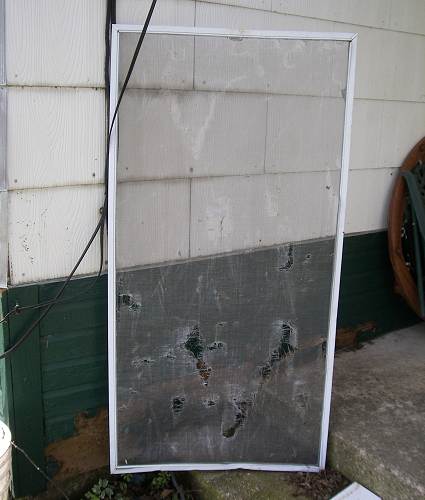
51 Screen Damage The air conditioner was knocked off its base and holes were made by the high velocity ice balls in the protective screen (photo 52).

52 Air Conditioner Damage The windshield of her car was completely broken and shattered and the body was covered with dents (photo 53).
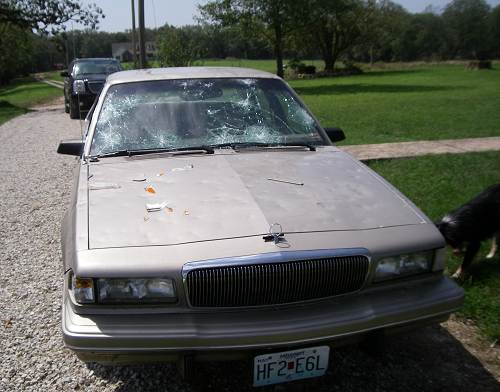
53 Car Damage Elva’s son, Donald Steen, was quoted by Autogram reporter Ginny Duffield in her article about the storm:
“Former county assessor Don Steen was out on his tractor when the storm hit, and he suffered some minor injuries from being hit in the head by large hail. He finally took shelter under the tractor. Steen said driveways on family property in the area look like shot puts had landed in them, splashing gravel out and throwing it several feet. Steen said he thinks the metal roof on his mother’s house will have to be replaced.”
Later, when Donald took the time to look, he found multiple bruises over his upper arms and torso. We heard reports of some calves and deer being killed in the area due to the hail. Donald told me that the tractor gave very little protection such that he soon ran to a nearby cedar tree which seemed to slow the hail balls a bit before they reached him.
Donald's and my wife’s sister, Sharon Steen Holder, encountered significant damage to her home, which is located just a mile north. She had shattered windows, roof damage and even damage to the TV aerial and roof vent (photos 54 and 55).
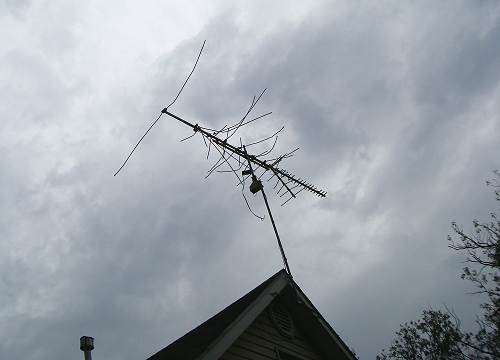
54 Aerial
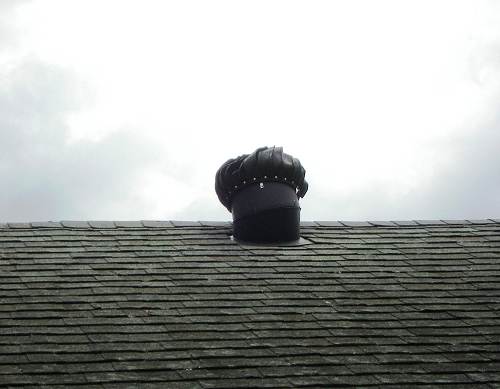
55 Air Vent In addition, take a look at the impact of the hail balls on the rail fence surrounding the house as well as the size of the holes in the deck flooring (photos 56 and 57).
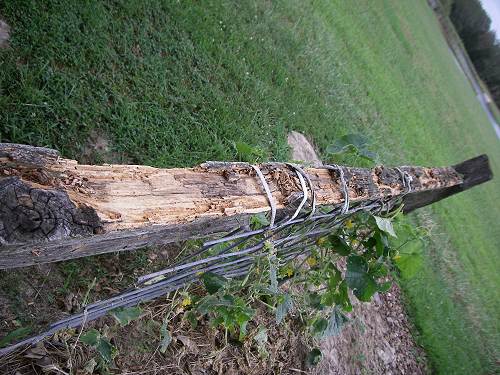
56 Rail Damage
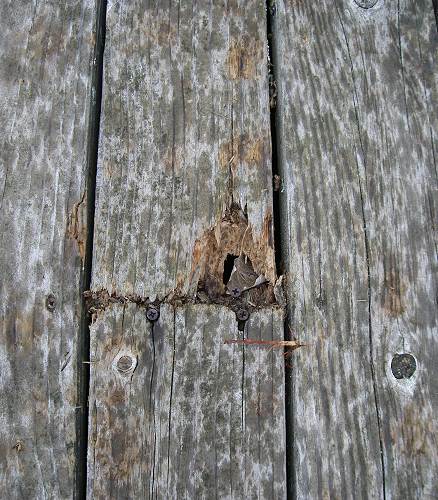
57 Deck Floor Damage This was an historic storm worse than anyone I know can remember regarding the extent of hail damage.
The following is an announcement in the July 21 edition of the Eldon Advertiser:
Tuscumbia plans celebration for bridge
A celebration is planned in Tuscumbia for the opening of the new Osage River Bridge, scheduled for Monday, Aug. 16.
The new bridge has been under construction since February
2009, started minutes after President Barack Obama signed the
American Recovery and Reinvestment Act, usually called the stimulus bill.
The Missouri Department of Transportation plans to hold a 10 a.m. ribbon cutting. Larry David Flaugher, one of the local organizers of festivities, said a small parade is planned, featuring people from around the county who had crossed the old suspension bridge before the current bridge replaced it in the 1930s. The parade will come across the new bridge and then travel to Riverside Park in Tuscumbia where the remainder of the festivities will take place.
Food will be available in the park and a variety of music groups are lining up to entertain, including Jacob “Toad” Wyrick’s 50’s band from Springfield and local groups. A vender will have T-shirts commemorating the event available.
Volunteers are needed to help. Anyone interested in helping may contact Flaugher at 573-392-0011.
That’s all for this week.
 Joe Pryor
Previous article links are in a dropdown menu at the top of all of the pages.
|

